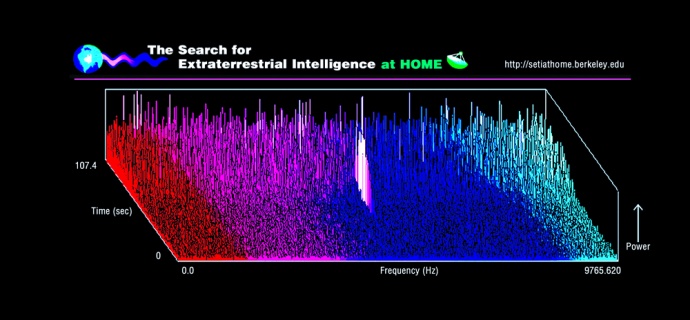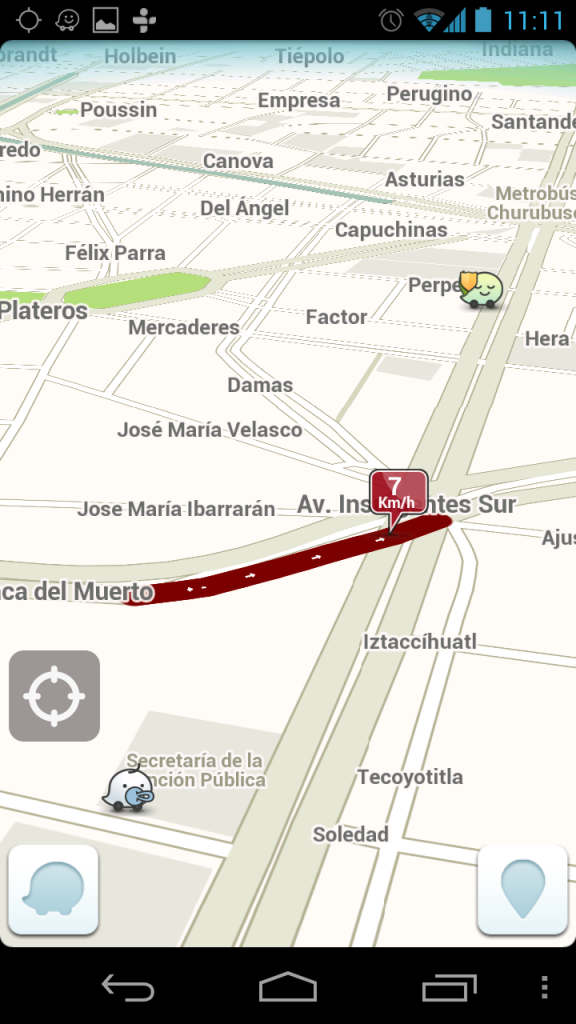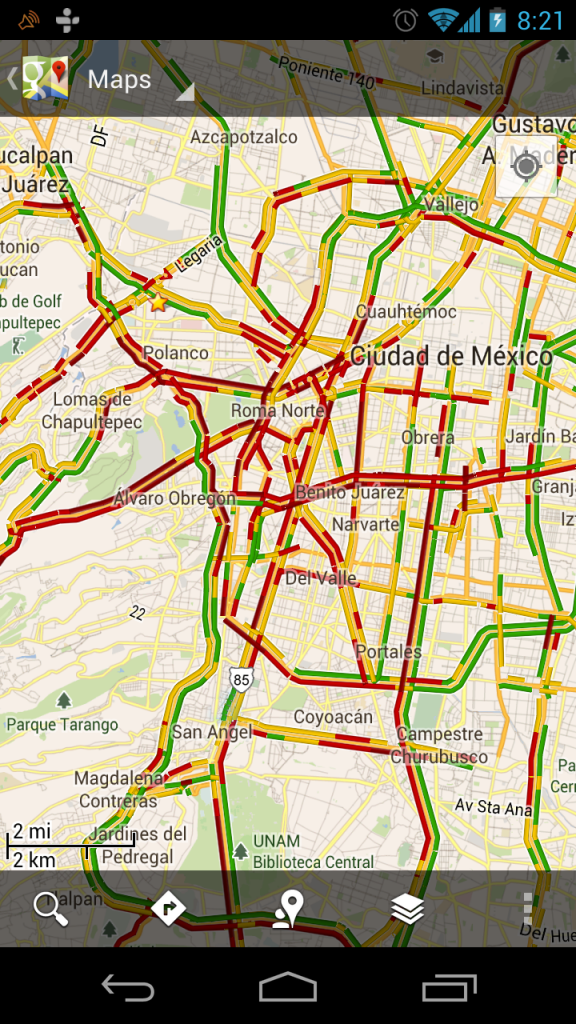Some years ago, the classic example of community based software was the SETI Project (http://setiathome.berkeley.edu), where sharing computing resources was the key to analyze and digest in parallel hundreds of thousands of data packets obtained from radio telescopes in SETI's network, to finally find a group of patterns robust enough to sustain them as proof of evidence of a intelligent life outside the earth.

Image of a SETI packet processing
While this initial approach was worthy of praise and a quite intelligent way to distribute a vast amount of packets to be processed individually instead of using a complex and very expensive infrastructure, the solution was based in the PC based technology platform prevalent in the 2000 (with windows and unix operating systems), so it relied in convincing a vast base of users to install a SETI client to use their idle cpu time in the form of a screensaver, or to dedicate resources in the form of server(s) for fully packet processing, in a competing race with other noble users usually from other countries, comparing the number of packets processed through a country and a personal project ranking.
This fascinating concept is having a new impulse, using nowadays the prevalent technology, benefiting from available computing power within an ample universe of mobile and internet based devices, Global Positioning System (GPS) location information, internet broadband access in 3G, 4G - LTE networks, using community collaborative software and services, where the main input and the one of the most valuable assets is the user's information provided back to the service.
Software is available for mobile platforms just like Android or IOS operating systems. One good example is the Waze app accessible in the most popular platforms, working with a central platform but requiring the constant input from a user base that constantly feeds back the service DB with traffic information such as car's speed, hazards on the road, accidents report, speed radars location, detected location of police officers, map errors, traffic bottlenecks and so on. In return Waze app assists you calculating a destination best route, showing up the traffic jam status almost in real time, avoiding conflictive zones based on previous feeds of existing users, where congestion is high. Of course no app is bullet proof and may lead you on a route with heavy traffic, but without a doubt is a great advance towards a service to optimize driver's time while on the road.
Continuing with the same app category, Google Maps allows a traffic jam mapping feature (available on certain cities), showing avenues on the city with high traffic indicators, marking them in red to be considered to the driver for alternative routes to the destination. All the feed for this signaling is given by internet enabled devices (smartphones and tablets), which in conjunction with their internal GPS, provides location and speed while driving to the Google Maps infrastructure to be processed and showed later on. The Green marking indicates fluid traffic and is an alternative route for driving while commuting.
While on the previous examples the information processing may be commited either on a dedicated infrastructure or on the software client's side, the real value obtained comes from the constant user's base input to the service. In general terms, crowdsourcing is related with distributing tasks to a base of collaborators to finally obtain a result in a more efficient manner, other than process by itself.
There is a thin boundary line to other computational concepts just like collaborative software, social networking or open source projects. In the former, there are similarity of objectives, because most of the open source software initiatives comes from sharing several tasks into normally a quite diverse communities from a country or from around the globe. Normally the resulting code is reviewed and improved by several entities, which makes the evolution of the open source software
Since the power of the community is present everywhere, and is the basis of the internet existance and its future evolution, maybe is less evident that the crowdsourcing examples seen previously are equivalent to the social networking popular platforms such as Facebook, Google+, LinkedIn, and Twitter, but they are similar since both depend entirely on their users contributions for the platforms to be current and attractive to them. The difference relays solely in the objective to be accomplished. What in a pre internet era was done using a notebook to record school mates information (in Mexico we called it as "Chismógrafo"), is done now using a internet enabled device, and a friendly user GUI to keep in contact, and to share personal data to a belonging group .
Nowadays the ramifications of the software and solutions that involve communities are in a continual evolving stage, and some are maturing faster than others, but all of them requires a user interaction as the main input. Nobody can argue the preeminence of the social networking as a tool to interact with omnipresence to a community, but also is a marketing instrument and a effective way to spread a customized message to group of interest, that in the most subtle manner of the term, may be considered as "buyers", because in masse they accept or unfollow trends, images, concepts, ideas, personalities, products, desires and so on.
In the Information Security realm, the risks identified for this social and computing movements relies precisely in the type of interaction required with the initiative , and the kind of information required for the user to feed the community software. Only for a moment we can think in forgetting possible legal implications and differences in the legal framework for the several countries where the solution or software operates, and concentrate in the dangers of the information publicly disseminated by the common user.
The following recommendations may apply, but depending on the nature of the service where the community user will collaborate.
- Protect yourself. Be sensitive when providing your personal information, avoid as possible to give your real name, credit/debit card info, Social Security Numbers (SSN), real home/work address unless there is a real reason to do so, use an alias instead.
- GPS is a wonderful location and driving tool. However when not handed properly, may lead others with no good intentions in a common platform, to find your travel patterns and to guess your home and work addresses. If it is not necessary, turn it off or disable the service settings to continually provide the GPS coordinates to the internet. Bluetooth is other service but local that could be turned off if its not in use.
- Verify the objective of the community and its outcomes. Installing software from unknown entities may become an issue since it may open the door to become a botnet node, if you don't feel confident at all avoid installing any software.
- Sharing personal pictures and depicting your personal environment is an enormous source of information to outsiders. When available, restrict your data only to trusted groups and check available filters to ensure you only show your information to the people you are confident to.
Conclusions
Software in the categories of Crowdsourcing, Social Networking and others, based in the concept of communities interaction or collaboration, is abundant and plenty of fascinating features. Crowdsourcing by itself is an efficient manner to distribute task otherwise expensive or hard to accomplish by a sole entity, and is an emerging growing trend that may have more services and software in the years to come. Other collaborative and social trends are well established and present in many forms in internet and in our daily life (ej Facebook, Twitter), but in all cases as long as it requires a user interaction with its information, it is necessary to restrict data to externals, via filters, configuration options, or displaying only info that in the worst scenario won't do any harm to the owner if mismanaged by outsiders with obscure motivations.
Author: David Ruiz


